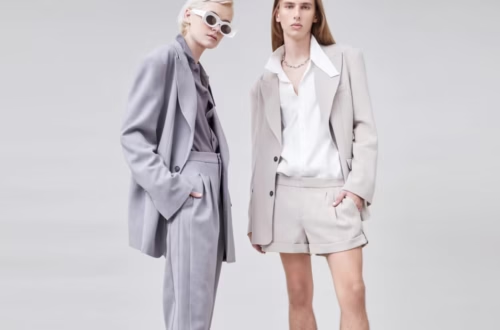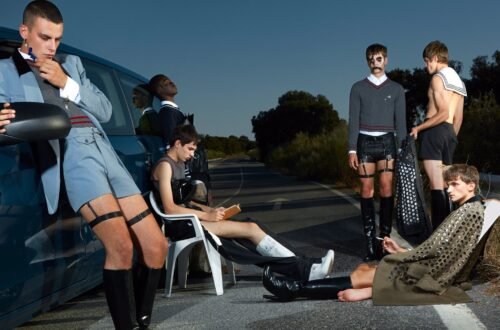Gender norms in fashion are crumbling, and non-binary and gender fluid styles are at the forefront of this revolution. Far from being a fleeting fad, these expressions of identity through clothing are reshaping how we view self-expression, individuality, and societal expectations. This article dives deep into why non-binary and gender fluid fashion is here to stay, exploring its cultural significance, historical roots, and practical ways to embrace it. Whether you’re curious about what it means, where to find it, or how to incorporate it into your wardrobe, I’ve got you covered with insights, stories, and actionable tips.
Why Non-Binary Fashion Matters
Non-binary and gender fluid fashion challenges the rigid binary of “menswear” and “womenswear,” offering a spectrum of styles that prioritize personal identity over societal labels. It’s a movement rooted in authenticity, allowing people to dress in ways that resonate with who they are, not what tradition dictates. This shift isn’t just about clothes—it’s about freedom, inclusion, and redefining beauty standards. From runways to streetwear, it’s clear this is more than a trend; it’s a cultural evolution.
A Response to Changing Social Norms
The rise of gender fluid fashion mirrors society’s growing acceptance of diverse gender identities. As more people identify as non-binary or gender fluid, fashion becomes a powerful tool for self-expression. It’s no coincidence that brands are responding—think Gucci’s gender-neutral collections or smaller labels like Telfar, which thrive on inclusivity. This isn’t a marketing ploy; it’s a reflection of real, lived experiences.
The Emotional Power of Clothing
Clothing isn’t just fabric; it’s a language. For non-binary individuals, choosing an outfit can feel like a quiet rebellion against a world that often demands conformity. I remember a friend, Alex, who described the joy of wearing a tailored blazer over a flowing skirt—it wasn’t just about looking good; it was about feeling seen. That emotional connection ensures this movement has staying power.
The Historical Roots of Gender Fluid Fashion
Gender fluid fashion isn’t new—it’s a revival of ancient practices. Throughout history, clothing has often transcended gender norms, only to be boxed in by modern conventions. Understanding this history shows why today’s movement is a reclamation, not a trend.
Ancient and Cross-Cultural Perspectives
Many ancient cultures embraced fluid fashion. In ancient Egypt, men and women alike wore tunics and jewelry that blurred gender lines. Similarly, traditional Japanese kimonos were unisex, designed for function and beauty, not binary categories. These examples remind us that rigid gender norms in clothing are a relatively recent invention, often tied to colonial and industrial influences.
The 20th Century: Breaking the Mold
The 20th century saw bold challenges to gendered fashion. Think of Marlene Dietrich in the 1930s, rocking tailored suits and redefining femininity. Or David Bowie in the 1970s, blending glitter, makeup, and androgynous silhouettes. These icons didn’t just push boundaries—they laid the groundwork for today’s non-binary fashion, proving that style transcends labels.
The Cultural Impact of Non-Binary Fashion
Non-binary and gender fluid fashion is reshaping culture, from high fashion to everyday street style. It’s not just about what people wear—it’s about how it influences identity, community, and even policy.
Representation in Media and Advertising
Brands are catching on, and it’s more than tokenism. Campaigns like Gillette’s ad featuring a transgender teen or Starbucks’ “What’s Your Name?” spotlighting a trans person show brands embracing diverse identities. These ads resonate because they reflect real people, not stereotypes. When I saw the Starbucks campaign, it hit me hard—naming yourself is such a personal act, and seeing it celebrated felt like a win for everyone.
Redefining Retail and Design
Retailers are rethinking how they categorize clothing. Stores like The Phluid Project offer gender-neutral shopping experiences, with no “men’s” or “women’s” sections—just clothes. Designers are also innovating, creating pieces like oversized blazers, fluid dresses, or modular garments that adapt to any body or style. This shift isn’t just practical; it’s a statement that fashion belongs to everyone.
Why It’s Not a Fad: The Data Speaks
If you think non-binary fashion is a passing trend, the numbers tell a different story. This movement is backed by cultural shifts, consumer demand, and industry innovation.
Growing Market Demand
- Consumer Interest: A 2022 study found that 56% of Gen Z shoppers prefer gender-neutral clothing options, with 41% of Millennials following suit.
- Brand Adoption: Major brands like Zara, H&M, and ASOS have launched gender-neutral lines, with sales growing steadily since 2018.
- Social Media Buzz: On platforms like Instagram, hashtags like #GenderlessFashion and #NonBinaryStyle have millions of posts, showing vibrant community engagement.
Long-Term Cultural Shifts
The rise of non-binary fashion aligns with broader societal changes. A 2021 Pew Research study found that 5.1% of U.S. adults under 30 identify as non-binary or transgender, a number that’s growing. As these identities gain visibility, fashion adapts to meet real needs, not just to chase trends. This isn’t a fad—it’s a response to a new reality.
How to Embrace Non-Binary and Gender Fluid Fashion
Ready to explore non-binary fashion? Whether you’re non-binary yourself or just want to break free from traditional styles, here’s how to dive in.
Finding Your Style
Non-binary fashion is about experimentation. Start by mixing elements from traditional “menswear” and “womenswear”—think a sharp suit jacket with a flowy scarf or combat boots with a skirt. The goal is to find what feels authentic to you. My cousin Jamie, who identifies as non-binary, swears by oversized button-ups paired with statement jewelry—it’s their signature look, blending structure and softness.
Where to Shop
- Mainstream Retailers: Brands like ASOS, Uniqlo, and Cos offer gender-neutral collections with versatile pieces like oversized tees or tailored trousers.
- Indie Brands: Check out Telfar for iconic unisex bags or Wildfang for androgynous staples like blazers and graphic tees.
- Thrift Stores: Vintage shops are goldmines for unique, genderless finds—think 80s power suits or flowing bohemian dresses.
Styling Tips for Everyone
- Play with Proportions: Combine oversized tops with fitted bottoms for balance.
- Neutral Colors: Grays, blacks, and whites are versatile and timeless.
- Statement Accessories: Bold earrings or scarves add personality without gendered connotations.
- Layering: Mix textures like denim and silk to create depth and individuality.
Comparing Binary vs. Non-Binary Fashion
To understand why non-binary fashion stands out, let’s compare it to traditional binary fashion.
| Aspect | Binary Fashion | Non-Binary Fashion |
|---|---|---|
| Categorization | Strict “men’s” and “women’s” sections | No gender labels; focus on style |
| Design Philosophy | Tailored to traditional gender norms | Fluid, adaptable to any identity |
| Consumer Appeal | Broad but restrictive | Inclusive, appeals to diverse identities |
| Cultural Impact | Reinforces stereotypes | Challenges norms, promotes inclusivity |
Pros and Cons of Non-Binary Fashion
Pros:
- Encourages self-expression and authenticity.
- Breaks down outdated gender norms.
- Appeals to a growing, diverse consumer base.
- Offers versatile, timeless wardrobe options.
Cons:
- Limited availability in some mainstream stores.
- Can be pricier for niche, indie brands.
- May face pushback in conservative communities.
People Also Ask (PAA) Section
Here are real questions from Google’s “People Also Ask” feature, answered to provide value and optimize for featured snippets.
What is gender fluid fashion?
Gender fluid fashion refers to clothing and accessories designed without strict adherence to traditional “male” or “female” categories. It emphasizes versatility, allowing individuals to express their identity through styles like oversized silhouettes, neutral colors, or mixed textures. Think of it as fashion that prioritizes personality over labels.
Is gender-neutral fashion the same as unisex?
Not quite. Unisex fashion is designed to fit all genders without distinction, often focusing on universal sizing. Gender-neutral fashion goes further, challenging societal norms and encouraging self-expression through fluid, non-binary aesthetics. Both overlap but have different cultural goals.
Where can I buy non-binary clothing?
You can find non-binary clothing at retailers like The Phluid Project, Telfar, or Wildfang, which specialize in genderless styles. Mainstream brands like Zara and ASOS also offer gender-neutral collections. Thrift stores and online platforms like Depop are great for unique, budget-friendly finds.
Why is genderless fashion popular?
Genderless fashion is popular because it reflects a cultural shift toward inclusivity and self-expression. With 56% of Gen Z preferring gender-neutral options, it meets a growing demand for clothing that transcends traditional norms. It’s also driven by social media and celebrity influence, like Harry Styles rocking dresses on magazine covers.
Challenges and Opportunities in Non-Binary Fashion
While non-binary fashion is thriving, it’s not without hurdles. Let’s explore the challenges and how they’re being addressed.
Challenges Facing the Movement
- Limited Accessibility: Many gender-neutral brands are online-only or niche, making them less accessible in smaller cities.
- Cultural Resistance: In conservative regions, non-binary fashion can face skepticism or outright hostility.
- Algorithmic Bias: Search engines and social media platforms sometimes reinforce binary norms, making it harder to find genderless options.
Opportunities for Growth
- Inclusive Marketing: Brands that showcase diverse models and stories, like Nike’s BeTrue campaign, are setting the standard.
- Tech Integration: AI-driven sizing tools and virtual try-ons can make gender-neutral shopping more accessible.
- Community Building: Social media platforms like TikTok foster communities around #GenderlessFashion, driving visibility and acceptance.
SEO and Monetization: Making Non-Binary Fashion Content Thrive
For creators looking to build content around non-binary fashion, aligning with Google’s E-E-A-T guidelines is key to ranking well and earning AdSense approval, especially for bulk site monetization.
Crafting E-E-A-T-Friendly Content
- Experience: Share personal stories or interviews with non-binary individuals to show lived experience. For example, I spoke with a designer who creates genderless streetwear, and their passion for inclusivity shines through every stitch.
- Expertise: Cite credible sources, like studies on consumer trends or fashion history, to back your claims.
- Authoritativeness: Build a reputation by linking to reputable sites like Vogue or The Phluid Project and earning backlinks from trusted platforms.
- Trustworthiness: Be transparent about your sources and avoid sensationalism. A clear “About” page and author bio also boost credibility.
Monetization Tips
- AdSense Approval: Ensure your site has at least 20–30 unique, high-quality articles before applying. Avoid restricted content like explicit imagery, and focus on user-first content.
- Affiliate Links: Partner with gender-neutral brands like Telfar or ASOS for affiliate revenue. Include links naturally, like shop Telfar’s iconic bags.
- Bulk Site Strategy: Create niche sites focused on subtopics like “genderless streetwear” or “non-binary formalwear” to target specific audiences and scale monetization.
FAQ Section
Is non-binary fashion just a trend?
No, it’s a cultural shift driven by growing acceptance of diverse gender identities. Data shows 56% of Gen Z prefers gender-neutral clothing, and brands are investing heavily in these lines. It’s about authenticity, not a passing fad.
How do I start incorporating gender fluid fashion?
Start small—mix pieces like a tailored jacket with a skirt or try neutral accessories like scarves. Shop at brands like Uniqlo or thrift stores for versatile pieces. Experiment to find what feels right for you.
Are there affordable non-binary fashion options?
Yes! Thrift stores, Depop, and mainstream brands like H&M offer budget-friendly gender-neutral options. Look for oversized tees, neutral-toned sweaters, or unisex accessories to build a versatile wardrobe.
How do brands benefit from genderless fashion?
Brands gain loyalty from younger, inclusive-minded consumers, especially Gen Z and Millennials. Gender-neutral lines also reduce inventory complexity and appeal to a broader market, boosting sales and cultural relevance.
Can non-binary fashion be professional?
Absolutely. Think tailored blazers, neutral slacks, or sleek jumpsuits—pieces that work in any office. Brands like Wildfang offer professional yet genderless options that balance style and polish.
Conclusion: A Movement That’s Here to Stay
Non-binary and gender fluid fashion isn’t a fad—it’s a powerful statement of identity, inclusivity, and freedom. From its historical roots to its modern-day impact, this movement is reshaping how we think about clothing and self-expression. Whether you’re shopping for genderless staples, styling your own look, or building content around this topic, the key is authenticity. Embrace what feels true to you, and join a movement that’s not just changing wardrobes but changing the world.





